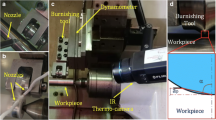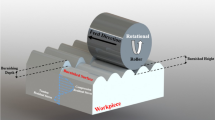Abstract
This study aims to evaluate how deep the roller burnishing (RB) operating variables (temperature, number of passes, and load applied by the bearing) affect the surface properties of an Inconel 718 part, in particular the surface roughness and nanohardness, based on nanoindentation results and image analysis techniques by confocal microscopy. It was evaluated how the intensity of these same variables of roller burnishing operations caused the phenomenon of strain-softening. Through the results obtained, it can be noted that, with up to two passes of RB, the surface roughness improves significantly. By increasing the number of RB passes, a discrete phenomenon of strain-softening deformation between the third and fourth RB passes in both operations at room temperature and at 310℃ was verified. For all RB operations (at room temperature and 310℃), the nanohardness levels (HV) were higher than those of the only turned sample, showing that, regardless of the test temperature the nanohardness of the part that underwent the RB operation increased. Metallographic analysis of the samples that underwent RB was performed and the abundant presence of the δ phase was observed. A gap was filled in research involving both the roller burnishing technique and the resulted properties of the Inconel 718.







Similar content being viewed by others
References
Mahto DG, Verma A, Roller Burnishing (2013) A literature review of developments and trends in approach to industrial application. Asian J Eng Technol 01:2321–2462. SSRN: https://ssrn.com/abstract=2774152
Okada M, Suenobu S, Watanabe K, Yamashita Y, Asakawa N (2015) Development and burnishing characteristics of roller burnishing method with rolling and sliding effects. Mechatronics 29:110–118. https://doi.org/10.1016/j.mechatronics.2014.11.002
Schulze V, Bleicher F, Groche P, Guo YB, Pyun YS (2016) Surface modification by machine hammer peening and burnishing. CIRP Ann 65:809–832. https://doi.org/10.1016/j.cirp.2016.05.005
Kurkut V, Chavan ST (2018) Modeling and optimization of surface roughness and microhardness for roller burnishing process using response surface methodology for Aluminum 63400 alloy. Procedia Manuf 20:542–547. https://doi.org/10.1016/j.promfg.2018.02.081
Boozarpoor M, Teimouri R (2021) Parametric study of multi-roller rotary burnishing process. Int J Light Mater Manuf 4:179–194. https://doi.org/10.1016/j.ijlmm.2020.10.001
El-Axir MH, Othmanb OM, Abodiena AM (2008) Improvements in out-of-roundness and microhardness of inner surfaces by internal ball burnishing process. J Mater Process Technol 196:120–128. https://doi.org/10.1016/j.jmatprotec.2007.05.028
Zhao J, Liu Z, Wang B, Cai Y, Song Q (2020) Analytical prediction and experimental investigation of burnishing force in rotary ultrasonic roller burnishing titanium alloy Ti–6Al–4V. J Manuf Sci Eng Trans ASME 142:031004–1/031004–9. https://doi.org/10.1115/1.4046027
Brezeanu LC (2015) Contact stresses between two cylindrical bodies: cylinder and cylindrical cavity with parallel axes – part I: theory and FEA 3D modeling. Procedia Technol 19:169–176. https://doi.org/10.1016/j.protcy.2015.02.025
Kułakowska A, Bohdal Ł (2020) Researches and simulation of elastic recovery phenomena during roller burnishing process of macro-asperities of surface. Materials 13(5276):19p. https://doi.org/10.3390/ma13225276
Kowalik M, Mazur T, Trzepiecinski T (2018) Assessment of the depth of the deformed layer in the roller burnishing process. Strength Mater 3:493–503. http://dspace.nbuv.gov.ua/handle/123456789/173917
Saritha PA (2014) Study on assessment of theories for contact stress distribution at roller - work piece contact in roller burnishing. International Journal of Science. Eng Technol Res (IJSETR) 01:100–106 (ISSN: 2278 – 7798)
Rotella G, Filice L, Micari F (2020) Improving surface integrity of additively manufactured GP1 stainless steel by roller burnishing. CIRP Ann 01:513–516. https://doi.org/10.1016/j.cirp.2020.04.015
Smirnov AV, Kuznetsova VA (2018) Factors affecting the surface roughness in burnishing. Russ Eng Res 10:814–817. https://doi.org/10.3103/S1068798X18100155
Capello E (2005) Residual stresses in turning. Part I: influence of process parameters. J Mater Process Technol 160:221–228. https://doi.org/10.1016/j.jmatprotec.2004.06.012
Capello E (2006) Residual stresses in turning. Part II. Influence of the machined material. J Mater Process Technol 172:319–326. https://doi.org/10.1016/j.jmatprotec.2005.10.009
Azarbarmas M, Aghaie-Khafria M, Cabrera JM, Calvo J (2016) Dynamic recrystallization mechanisms and twining evolution during hot deformation of Inconel 718. Mater Sci Eng, A 678:137–152. https://doi.org/10.1016/j.msea.2016.09.100
Bei H, Xia YZ, Barabash RI, Gao YF (2016) A tale of two mechanisms: strain-softening versus strain-hardening in single crystals under small stressed volumes. Scripta Mater 01:48–52. https://doi.org/10.1016/j.scriptamat.2015.07.043
Klotz T, Blas S, Lévesque M, Brochu M (2017) 1D cyclic yield model independent of load spectrum characteristics and its application to Inconel 718. Mech Mater 109:34–41. https://doi.org/10.1016/j.mechmat.2017.03.011
Leppert T, Peng RL (2009) Surface residual stresses in dry turning of 0.45% C steel. International Centre for Diffraction Data, 304–311. ISSN 1097–0002,
Caruso S, Umbrello D, Outeiro JC, Filice L, Micari F (2011) An experimental investigation of residual stresses in hard machining of AISI 52100 steel. Procedia Eng 19:67–72. https://doi.org/10.1016/j.proeng.2011.11.081
Chamanfar A, Sarrat L, Jahazi M, Asadi M, Weck A, Koul AK (2013) Microstructural characteristics of forged and heat treated Inconel-718 disks. Mater Des 52:791–800. https://doi.org/10.1016/j.matdes.2013.06.004
Anderson M, Thielin AL, Bridier F, Bocher P, Savoie J (2017) δ Phase precipitation in Inconel 718 and associated mechanical properties. Mater Sci Eng, A 679:48–55. https://doi.org/10.1016/j.msea.2016.09.114
Anbarasan N, Gupta BK, Prakash S, Muthukumar P, Oyyaravelu R, Kumar RJF, Jerome S (2018) Effect of heat treatment on the microstructure and mechanical properties of Inconel 718. Mater Today: Proc 5:7716–7724. https://doi.org/10.1016/j.matpr.2017.11.448
Fu T, Peng X, Chen X, Weng S, Hu N, Li Q, Wang Z (2016) Molecular dynamics simulation of nanoindentation on Cu/Ni nanotwinned multilayer films using a spherical indenter. Sci Rep 6(35665):10p. https://doi.org/10.1038/srep35665
Voyiadjis GZ, Yaghoobi M (2017) Review of nanoindentation size effect: experiments and atomistic simulation. Crystals 7(321):28p. https://doi.org/10.3390/cryst7100321
Ruestes CJ, Alhafez IA, Urbassek HM (2017) Atomistic studies of nanoindentation—a review of recent advances. Crystals 7(293):15p. https://doi.org/10.3390/cryst7100293
Merle B, Maier-Kiener V, Pharr GM (2017) Influence of modulus-to-hardness ratio and harmonic parameters on continuous stiffness measurement during nanoindentation. Acta Mater 01:167–176. https://doi.org/10.1016/j.actamat.2017.05.036
Hua Y, Liu Z, Wang B, Ho X (2019) Surface modification through combination of finish turning with low plasticity burnishing and its effect on fatigue performance for Inconel 718. Surf Coat Technol 15:508–517. https://doi.org/10.1016/j.surfcoat.2019.07.057
Yuan H, Liu WC (2005) Effect of the δ phase on the hot deformation behavior of Inconel 718. Mater Sci Eng, A 408:281–289. https://doi.org/10.1016/j.msea.2005.08.126
Casarin SJ, De Angelo Sanchez LE, Bianchi EC, Scalon VL, Fragelli RL, De Godoi EL, Cindra Fonseca MP (2021) Effect of burnishing on Inconel 718 workpiece surface heated by infrared radiation. Mater Manuf Processes 36:1853–1864. https://doi.org/10.1080/10426914.2021.1926494
Acknowledgements
The authors also thank Dr. Paulo Noronha Lisboa Filho (Dept. Physics Unesp Bauru) for making the confocal microscope available to this research and Dr. Paulo César Soares Júnior (Pontifical Catholic University of Paraná, Polytechnic School, Department of Mechanical Engineering, Curitiba-Brazil) for making the indentations tests to this research.
Funding
This work was supported by CAPES- Brazil. Coordenação de Aperfeiçoamento de Pessoal de Nível Superior—Brasil (CAPES) – Grant number: 88882.317754/2019–01.
Author information
Authors and Affiliations
Contributions
Eduardo Luiz de Go methodology, investigation, and formal analysis. Samuel José Casarin: conceptualization and writing—original draft and editing. Gilberto de Magalhães Bento Gonçalves: writing—reviewing and editing. Luiz Eduardo de Angelo Sanchez: project administration, resources, and validation.
Corresponding author
Ethics declarations
Conflict of interest
The authors declare no conflict of interest.
Additional information
Publisher's Note
Springer Nature remains neutral with regard to jurisdictional claims in published maps and institutional affiliations.
Rights and permissions
Springer Nature or its licensor (e.g. a society or other partner) holds exclusive rights to this article under a publishing agreement with the author(s) or other rightsholder(s); author self-archiving of the accepted manuscript version of this article is solely governed by the terms of such publishing agreement and applicable law.
About this article
Cite this article
de Godoi, E.L., Casarin, S.J., de Magalhães Bento Gonçalves, G. et al. Relationship of the roller burnishing process parameters with the surface and subsurface properties of Inconel 718. Int J Adv Manuf Technol 129, 5359–5370 (2023). https://doi.org/10.1007/s00170-023-12672-8
Received:
Accepted:
Published:
Issue Date:
DOI: https://doi.org/10.1007/s00170-023-12672-8




